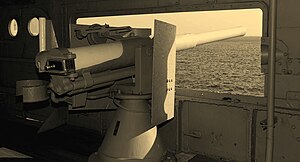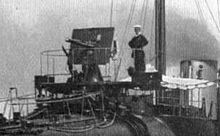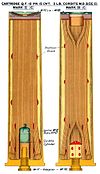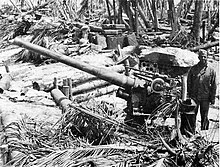| QF 12-pounder 12 cwt naval gun Type 41 3-inch (7.62 cm) 40 calibre gun | |
|---|---|
 Type 41 3-inch (7.62 cm) 40 calibre gun on the Japanese battleship Mikasa Type 41 3-inch (7.62 cm) 40 calibre gun on the Japanese battleship Mikasa | |
| Type | Naval gun Coastal artillery |
| Place of origin | United Kingdom |
| Service history | |
| In service | 1894–1945 |
| Used by | United Kingdom Kingdom of Italy Empire of Japan |
| Wars | Second Boer War British colonial conflicts Irish 1916 Easter Rising Boxer Rebellion Russo-Japanese War World War I World War II |
| Production history | |
| Designed | 1893 |
| Manufacturer | Elswick Ordnance Company, Vickers, Japan Steel Works Canadian Pacific Railway Gio. Ansaldo & C. |
| No. built | Mk I, Mk II 4,737 Mk V 3,494 |
| Variants | Mk I, Mk II, Mk V |
| Specifications | |
| Mass | 12 cwt (0.6 tons, 510 kg) |
| Length | 10 ft 3 in (3.12 m) |
| Barrel length | 10 ft (3 m) |
| Shell | UK & Japan : Separate-loading QF Italy : Fixed QF |
| Calibre | 3-inch (7.62 cm) |
| Breech | single-motion screw |
| Elevation | mounting dependent |
| Traverse | mounting dependent |
| Rate of fire | 15 rounds per minute |
| Muzzle velocity | 2,210 ft/s (670 m/s) |
| Effective firing range | 11,750 yd (10,740 m) at 40° elevation |
| Feed system | Breech-loaded |
The QF 12-pounder 12-cwt gun (Quick-Firing) (abbreviated as Q.F. 12-pdr. ) was a common, versatile 3-inch (76.2 mm) calibre naval gun introduced in 1894 and used until the middle of the 20th century. It was produced by Armstrong Whitworth, Elswick and used on Royal Navy warships, exported to allied countries, and used for land service. In British service "12-pounder" was the rounded value of the projectile weight, and "12 cwt (hundredweight)" was the weight of the barrel and breech, to differentiate it from other "12-pounder" guns.
As the Type 41 3-inch (7.62 cm)/40 it was used on most early battleships and cruisers of the Imperial Japanese Navy, though it was commonly referred to by its UK designation as a "12-pounder" gun. Italy built guns under licence as the 76.2 mm/40 (3") by Ansaldo.
United Kingdom service
United Kingdom naval service


Mk I and II guns, of "built up" construction of steel layers, served on many Royal Navy destroyers up to and after World War I originally as primary and later as secondary armament against submarines and torpedo boats. They were also fitted as deck guns on D and E-class submarines.
It was estimated that out of the 4,737 Mk I and Mk II guns produced there were still 3,494 on hand for the RN in 1939. Many Mk V guns, which had a "monobloc" barrel made of a single casting, served on smaller escort ships such as destroyers and on armed merchant ships, on dual-purpose high–low angle mountings which also allowed it to be used as an anti-aircraft gun.
Gun mounting data
| Mounting | Elevation | Weight including gun |
|---|---|---|
| PI* | -10° to +30° | 1.23 tons / 1,253 kg |
| HA VIII | -10° to +90° | 2.10 tons / 2,134 kg |
| HA/LA IX | -10° to +70° | 2.45 tons / 2,489 kg |
| This section needs expansion. You can help by adding to it. (May 2008) |
South African War (1899–1902) land service

The gun was primarily a high-velocity naval gun, with its heavy recoil suiting it to static mountings, hence it was generally considered unsuitable for use as a mobile field gun. An exception was made when the British army were outgunned by the Boer artillery in South Africa and the Royal Navy was called on for help. Among other guns, 16 QF 12-pounder 12 cwt were landed from warships and were mounted on improvised field carriages designed by Captain Percy Scott RN, with solid wooden trails and utilizing small-diameter Cape wagon wheels. Their 10,000-yard (9,100 m) range provided valuable long-range fire support for the army throughout the war. They were known as "long twelves" to distinguish them from the BL 12-pounder 6 cwt and QF 12-pounder 8 cwt which had much shorter barrels and ranges.
Lieutenant Burne reported that the original electric firing system, while working well under ideal conditions, required support of an armourer and the maintenance and transport of charged batteries in the field, which was generally not possible. He reported switching to percussion tubes for firing and recommended percussion for future field operations.
Another six guns were diverted from a Japanese battleship being built at Newcastle in January 1900, bought by Lady Meux, and were equipped with proper field carriages by the Elswick Ordnance Company in Newcastle and sent to South Africa. Perhaps uniquely, the guns were refused by the War Office and donated directly to Lord Roberts, the British commander in South Africa and became his personal property. They were known as the "Elswick Battery" and were manned by men from Elswick, recruited by 1st Northumberland Royal Garrison Artillery (Volunteers). The Elswick guns served throughout the war.
Coast defence gun

Many guns were mounted on "pedestals" secured to the ground to defend harbours around the UK, and at many ports around the Empire, against possible attack by small fast vessels such as torpedo boats, until the 1950s. There were 103 of these guns (of a total 383 of all types) employed in coast defence around the UK as at April 1918. Many of these were still in service in World War II although they had by then been superseded by more modern types such as twin QF 6-pounder 10 cwt mounts.
Guns were traversed (moved from side to side) manually by the gunlayer as he stood on the left side with his arm hooked over a shoulder piece as he aimed, while he operated the elevating handwheel with his left hand and grasped the pistol grip with trigger in his right hand.
Army anti-aircraft gun
Main article: QF 12-pounder 12 cwt AA gunIn World War I a number of coast defence guns were modified and mounted on special wheeled traveling carriages to create a marginally effective mobile anti-aircraft gun.
United Kingdom ammunition
UK shells weighed 12.5 lb (5.67 kg) filled and fuzed.
The cordite propellant charge was normally ignited by an electrically activated primer (in the base of the cartridge case), with power provided by a battery. The electric primer in the cartridge could be replaced by an adaptor which allowed the use of electric or percussion tube to be inserted to provide ignition.
 |
 |
 |
 |
 |
| 2 lb Cordite cartridges Mk II & Mk III, 1914 | Mk II common pointed shell | Mk III & Mk II common Lyddite shell | Mk IV common Lyddite shell with internal night tracer, 1914 | Mk IX shrapnel shell, 1914 |
Italian service
| This section needs expansion. You can help by adding to it. (August 2020) |
The Italian Cannon 76/40 Model 1916 was a licensed derivative of the QF 12-pounder used in a number of roles during World War I and World War II.
Japanese service

The Japanese Type 41 3-inch (76 mm) naval gun was a direct copy of the QF 12-pounder. The first guns were bought from the English firms as "Elswick Pattern N" and "Vickers Mark Z" guns. The gun was officially designated as the Type 41 3-inch (76 mm) naval gun from the 41st year of the reign of Emperor Meiji on 25 December 1908. Thereafter production was in Japan under license. On 5 October 1917 during the third year of the Taishō period, the gun was redesignated as the 8 cm/40 3rd Year Type naval gun as part of the Imperial Japanese Navy's conversion to the metric system. Although classified as an 8 cm gun the bore was unchanged. The gun fired a 12.5-pound (5.7 kg) high-explosive shell. It was the standard secondary or tertiary armament on most Japanese warships built between 1890 and 1920, and was still in service as late as the Pacific War.
The 8 cm/40 3rd Year Type was also widely used as a coastal defense gun and anti-aircraft gun to defend Japanese island bases during World War II. Guns with both English and Japanese markings were found on Kiska, Kolombangara, Saipan, Tarawa, and Tinian. Japanese Artillery Weapons CINPAC-CINPOA Bulletin 152-45 calls the guns "8 cm Coast Defense Gun 13th Year Type (1924)" but it isn't clear how they came up with that designation?
Surviving guns

- A gun of the Elswick Battery that served in the Second Boer War is displayed in the Royal Artillery Museum, London but the museum has closed and re-located to Larkhill, Wiltshire.
- Another Elswick gun is with 203 (Elswick) Battery RA (V)
- Mk V naval gun was at Royal Artillery Museum, London but the museum has closed and re-located to Larkhill, Wiltshire.
- Early coast defence gun at Newhaven Fort, UK
- Coast defence gun at Army Memorial Museum, Waiouru, New Zealand]
- On the battleship Mikasa, Yokosuka, Japan
- The gun of HMS Campbeltown, recovered around 1972, on display in Saint-Nazaire, France
- 12-pdr on coastal defence pedestal at Pendennis Castle, Falmouth, Cornwall
- The gun of HMS Overdale Wyke of the Ceylon Naval Volunteer Force, now kept in SLNS Ranagalle
- A good example can be seen mounted at Tilbury Fort in Essex. This is an ex-naval type of WW2 vintage.
- A 12-pdr of First World War vintage is mounted on a skeletal high-angle mount at Predannack Anti-Aircraft battery and museum in Cornwall
- At Explosion Museum of Naval Firepower, Gosport, UK
Gallery
See also
Notes
- 2,210 ft/s in British service in 1902, using 1 lb 15 oz (0.88 kg) cordite Mk I size 15 propellant; 2,258 ft/s (688 m/s) in British service in World War I using 2 lb (0.91 kg) cordite MD size 11 propellant
- Campbell, Naval Weapons of WWII, p.62-63.
- Text Book of Gunnery 1902
- Hogg & Thurston 1972, p. 55.
- ^ Gun drill for Q.F. 12-pdr. (12-cwt.) gun (Land service) 1925, the War Office, 1925
- ^ Campbell, Naval Weapons of WWII, p.64.
- ^ Hogg and Thurston 1972, p. 54
- Hall June 1978
- Burne 1902, Chapter IX
- Crook June 1969
- Farndale 1988, p. 404
- DiGiulian, Tony. "3"/40 (7.62 cm) 41st Year Type". NavWeaps.com.
- Japanese Artillery Weapons. United States Pacific Fleet and Pacific Ocean Areas. 1 July 1945. p. 33. OCLC 51837610.
- "History". www.army.mod.uk. Archived from the original on 8 October 2007. Retrieved 13 January 2022.
- "PunTheHun".
References
Books
- Text Book of Gunnery, London: HMSO, Harrison and Sons, 1902, archived from the original on 12 July 2012, retrieved 28 September 2008
- Brown, D. K. (2003). Warrior to Dreadnought: Warship Development 1860–1905. Book Sales. ISBN 978-1-84067-529-0.
- Brown, D. K. (2003). The Grand Fleet: Warship Design and Development 1906–1922. Caxton Editions. ISBN 978-1-84067-531-3.
- Lieutenant C. R. N. Burne R.N., With the Naval Brigade in Natal (1899–1900). London: Edward Arnold, 1902
- Farndale, General Sir Martin (1988). History of the Royal Regiment of Artillery. The Forgotten Fronts and the Home Base, 1914–18. Royal Artillery Institution, London. ISBN 978-1-870114-05-9.
- Gardiner, Robert; Lambert, Andrew, eds. (2001). Steam, Steel and Shellfire: The Steam Warship, 1815–1905. Conway's History of the Ship. Book Sales. ISBN 978-0-7858-1413-9.
- Hodges, Peter (1981). The Big Gun: Battleship Main Armament, 1860–1945. United States Naval Institute Press. ISBN 978-0-87021-917-7.
- Hogg, I.V.; Thurston, L.F. (1972). British Artillery Weapons & Ammunition 1914–1918. London: Ian Allan. ISBN 978-0-7110-0381-1.
- Parkes, Oscar (1990) . British Battleships. United States Naval Institute Press. ISBN 978-1-55750-075-5.
- Admiral Percy Scott, "Fifty Years in the Royal Navy" published 1919
- Campbell, John (1985). Naval Weapons of World War Two. Naval Institute Press. ISBN 978-0-87021-459-2.
External links
- DiGiulian, Tony. "12-pdr [3"/40 (7.62 cm)] 12cwt QF Marks I, II and V". NavWeaps.com.
- Major D Hall, The South African Military History Society. Military History Journal – Vol 4 No 3 June 1978. THE NAVAL GUNS IN NATAL 1899–1902
- Major L.A. Crook,The South African Military History Society. Military History Journal – Vol 1 No 4 June 1969. "The Elswick Guns"
- 203 (Elswick) Battery History
| British Empire naval weapons of the Victorian era | |
|---|---|
| Smoothbore muzzle-loading cannons | |
| Smoothbore muzzle-loading shell guns | |
| Mortars | |
| Howitzers | |
| Rifled breechloaders (Armstrong) |
|
| Rifled muzzle-loaders (Lancaster) | |
| Rifled muzzle-loaders (converted) | |
| Rifled muzzle-loaders (Woolwich) | |
| Breech-loaders (new pattern) | |
| Quick-firing guns | |
| Light weapons | |
| Torpedoes | |
| British Empire naval weapons of the First World War | |
|---|---|
| Monitor guns | |
| Capital ship main armament | |
| Armoured cruiser main armament | |
| Secondary armament and light cruiser main armament | |
| Destroyer and small cruiser armament | |
| Merchant ship armament | |
| Submarine guns | |
| Anti-aircraft guns | |
| Light weapons | |
| Torpedoes | |
| Mines | |
| Anti-submarine weapons | |
| Landing guns | |
| British Empire artillery of the First World War | |
|---|---|
| Armoured vehicle guns | |
| Infantry guns | |
| Field artillery | |
| Medium & heavy artillery | |
| Siege artillery | |
| Mountain artillery | |
| Mortars | |
| Smoke and chemical weapons |
|
| Anti-aircraft guns | |
| Coastal artillery | |
| Railway guns | |
| British Commonwealth naval weapons of the Second World War | |
|---|---|
| Monitor guns | |
| Capital ship main armament | |
| Heavy cruiser main armament | |
| Secondary armament and light cruiser main armament | |
| Minesweeper, Sloop, Corvette, Frigate and Destroyer armament | |
| Submarine guns | |
| Anti-aircraft weapons | |
| Light weapons | |
| Torpedoes | |
| Anti-submarine weapons |
|
| Small craft armament | |
| Foreign-sourced weapons | |






